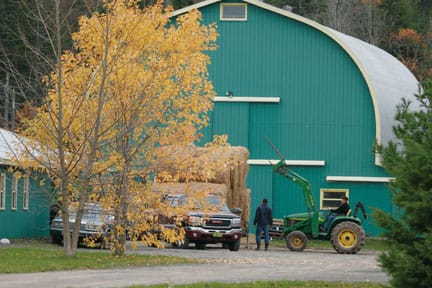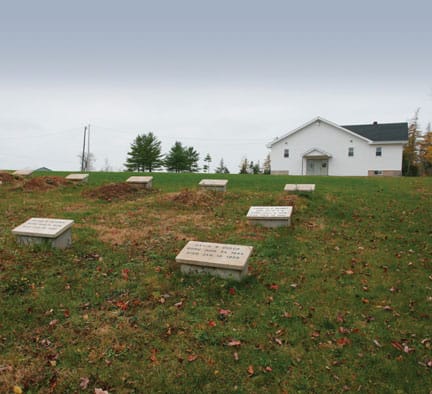To conservative Mennonites, first comes marriage then comes love. But there's no question of commitment-to the community or the cause.
Drinking a cup of tea at the dining room table, Leroy Boese is about to share the story of how he and his wife, Gwen, came to be married. He smiles self-consciously-by today's standards it's an unconventional story. At the moment Leroy knew Gwen was the one, he hadn't yet met her. "We were sitting inside, doing some singing and visiting," he says. "Then something said to me, 'Your wife-to-be is in this room.' As soon as I saw Gwen, it hit me: she's the one."
Despite the clarity of that moment, it took Leroy a few years to ask Gwen to marry him. "I prayed about it for three years," he says, 28 years and four sons later. "I saw Gwen a couple of times in between and every time, I knew. But she didn't know I felt that way."
There was no way Gwen could know. Leroy and Gwen Boese are members of a small conservative Mennonite community in Brule, NS, where there is no such thing as dating. Instead, they believe God will provide the person with whom they will spend the rest of their lives. The young man then talks with his minister before approaching the woman's parents with a proposal.

While the idea of a marriage decreed by God may sound unromantic to many Westerners, Leroy has a different perspective. "With our marriages, the courtship never ends," he says. As a minister at the church and a trusted confidant, he's in a position to know about these matters of the heart.
Romantic Mennonites? It isn't a typical association. Indeed, the images conjured up by the word "Mennonite" are more likely those of the reserved, hard-working men and women cut from the same cloth standing behind mounds of produce at farmers' markets. The women wear headscarves, hand-sewn dresses of similar pattern and no makeup or jewelry; men wear trousers and buttoned-up shirts. The children are well behaved, silently watchful of the stranger in their midst. This conformity can be unnerving to someone born and raised in an average, boisterous household of the 20th century. But after spending time breaking bread with one of these families I came to realize that conformity, and the peer pressure that goes with it, is the only way to protect and maintain a very traditional, deeply religious way of life.
While white clapboard churches on back roads and in small towns are Atlantic Canadian icons, stepping into a rural Mennonite church is like stepping into another, older world. Men and boys sit on one side of the church, women and girls on the other. The interior, with its white paint and wooden pews, is as unadorned as the Mennonites who gather several times a week for worship and study. There are no stained glass windows, no crosses on the walls or around necks. The Mennonites follow a literal interpretation of the New Testament scriptures, which state that true beauty comes from the inner spirit.
Elizabeth Dueck of Northfield, NS, becomes almost poetic when she discusses why women don't wear makeup or jewelry. "Without it, a person's heart is easier to see," she says softly. "The spirit is what matters. We don't believe in trying to attract someone by our appearance."
With strict rules about dress, courtship and faith, it isn't easy for a conservative Mennonite community to attract converts, which helps explain why communities remain small and isolated. According to the 2001 census, there are 795 people in Nova Scotia who identify themselves as Mennonites, and 150 in New Brunswick. Not all of them are conservative, however. While the Kleine Gemeinde community in Northfield, NS, and the Holdeman's in Berwick and Brule, NS, and Centreville, NB, are conservative, there are several modern Mennonite communities in Atlantic Canada: the Mennonite Church Canada in Petitcodiac, NB, and the Mennonite Brethren churches located in Lower Sackville and Halifax, NS, and Campbellton, Moncton and Riverview, NB.
Peter Penner is a so-called modern Mennonite who taught history at Mount Allison University in Sackville, NB, for 27 years; his family was part of the Russian emigration to Manitoba in the 1920s. He says that while there are four distinct Mennonite groups, most of the attention goes to the more conspicuous conservative ones. "They deserve it because they are true to their faith and background and culture," Peter says. "People like myself wouldn't be known as Mennonite unless we talked about our background and faith. We wouldn't be visible."
Elizabeth and Walter Dueck were both born in Belize, Central America; their parents and grandparents were part of the second and third waves of immigration to Manitoba. Several families, including the Duecks, moved to Northfield in the early 1980s, choosing Nova Scotia because of the availability of farmland. The community is now home to about 300 people.
The Duecks, who were married three years ago and have two young children, are building their own home with Walter, a carpenter, doing most of the work. Right now, they live in the walk-out basement of the unfinished four-bedroom home. "It will take a couple of years to finish," Elizabeth says. She doesn't lament about how inconvenient it might be. She says they'll do what's necessary. "A young couple will not go out and build a $300,000 house," adds Walter. "We are commanded to live simply, within our means. It is not a priority to have a nice house."
While conservative Mennonites follow the guidelines of simplicity, economy and modesty, they also value comfort and convenience-they use microwaves and drive vehicles with air conditioning, for example. There are no televisions or radios or computers in the homes (unless used for business) because they're considered distractions from the Mennonites' devout Christian beliefs. However, they appear to be too busy with work and family and church to actually sit down and watch TV anyway. In 2002, Statistics Canada found that the children in Old Order Mennonite communities in Ontario, also conservative but with a different lineage, were in better physical shape than their peers, a reflection of the rural lifestyle and hard work that are cornerstones of a conservative Mennonite community.
 As with the segregation of sexes in church there's a division of labour, following traditional male-female roles. Along with the care of the children, Mennonite women tend to spend their summers canning, jamming and pickling. In the winter they catch up on sewing clothes for themselves and their children, while men's shirts and pants are store-bought.
As with the segregation of sexes in church there's a division of labour, following traditional male-female roles. Along with the care of the children, Mennonite women tend to spend their summers canning, jamming and pickling. In the winter they catch up on sewing clothes for themselves and their children, while men's shirts and pants are store-bought.
Economic realities, however, are changing the way Mennonites interact with the outside world. More and more men, and in some cases women, are forced to find non-farming employment. "Most of us must work outside the community to make a living," says Walter Dueck, who has a large greenhouse and sells garden plants at the farmers' market in Truro. A brother-in-law is a cabinet maker, while his father and brother build furniture.
No matter what skills they have, Mennonites prefer work that they can do close to home, a preference that reinforces the impression that they keep to themselves. "We are very much a rural-loving people, so our occupations tend to be influenced by that," says Leroy Boese. "There used to be more farming but more and more of us are working as tradesmen. Some have small businesses like meat cutting, a machine shop, bakery, beekeeping, carpentry, harvesting wood." Although Leroy raises sheep to sell for meat, he also works for a local plumbing and electrical company.
Regardless of where their income comes from, Mennonites pay income and property taxes the same as everybody else. "And we do accept child tax benefits and pensions. We appreciate them," says Leroy's wife, Gwen, a former licensed practical nurse (single women work until they get married and have children) who returned to work as a personal care worker at a nursing home in Tatamagouche once her four boys were grown. Gwen could be considered exceptional in that she not only works outside the home but also outside the community. Yet the job opportunities available to women are typically nursing, teaching at their parochial school or helping with the family business-still traditional women's work. Sometimes, however, tragedy and circumstance forces women to take on a different role. Elizabeth Dueck's mother, whose husband was killed in a tractor accident four years after they arrived in Nova Scotia, maintains two cows for her own use, making her own cheese, butter, milk and cream and butchering the calves for meat. She still manages her family's six acres of market garden, selling the vegetables at the farmers' markets in Truro and Halifax as well as to wholesalers.
The occupations open to conservative Mennonites-men and women-are also determined by the fact that people are schooled only to their early teens. Conservative Mennonites don't believe in higher education, says Peter Penner, who was raised in a traditional Mennonite community in Ontario. "The daughters go home and are trained by their mothers. They prepare for marriage. The males go home and work with their fathers, either on the farm or on contracts. I dropped out of high school at age 15 thinking I had to help my parents. Then I went on to finish high school at age 25," he says, adding that he earned a PhD at the age of 39. "I went back because I wanted to do something [different] with my life." During the years Peter and his wife, Justina, lived in Sackville, they visited her Manitoba connections living at the Northfield settlement. "They found me pretty strange," he recalls. "They believe in Grade 7 and here they had to cope with someone who had gone all the way."
One thing Peter has in common with his conservative brethren is a commitment to helping others. Because of their early history of moving from country to country to avoid persecution and conscription (see "A People on the Move," opposite), Mennonites are devoted to helping those in Third World countries. On one of the many gravel roads in Northfield is a large, two-storey building, a nondescript corrugated steel-sided structure with no sign to indicate what it's used for. This is the heart of the Northfield community's mission and outreach work, which began many years ago in the basement of the church. Under the banner of the Christian Relief Service, the Mennonites collect used clothing then sort it, pack it (a specially designed machine compresses the clothes into feed-style bags) and ship the clothing to Mennonite missions in developing countries. The community fills on average two shipping containers every year with 700 bales of clothing plus dozens of boxes of shoes. The sorting and packing work fills the cold days and long evenings during the winter.
In Petitcodiac, NB, Joanne DeJong says there are three characteristics that define any Mennonite: hard-working, passionate about their faith and practical. "Mennonites, no matter whether they are Old Order or modern, live life in the name of Christ," she says. "We believe that it pleases God to care for the poor. I think if you're compassionate and hard-working and practical and you love God, great things can happen."
Joanne is the Atlantic co-ordinator of sales for Ten Thousand Villages, a Mennonite outreach program that helps people in 30 Third World countries produce traditional crafts that are then sold across North America. "Basically it's a job creation program," Joanne says. "We are training a village of people to have a business. We provide the startup money and advise them but the dream is for them to run a business; they own it, they operate it."
There's a Ten Thousand Villages store in Petitcodiac; in Nova Scotia Ten Thousand Villages has paired up with Just Us! Fair Trade Coffee Roasters in Halifax and Grand Pré-but the program is better known through participation in weekend shopping fairs and craft sales throughout the region. Everything from jewelry and toys to pottery and linens and wall hangings are available, from countries such as Bangladesh, Vietnam, Indonesia and the Philippines.
"The public response is incredible," Joanne says. "People are much more aware of what's going on in the world… Are children making our stuff? What protection is there for workers? Are they having to work in unsafe conditions or in sweat shops? People are thinking about these issues."
Despite their faithful support of those living in Third World countries, conservative Mennonites aren't likely to shop at a Ten Thousand Villages sale, however. Leroy and Gwen's rural home is large, spacious and comfortable, but very much lacking in the "stuff" with which most of us fill our homes-particularly photographs. In the Boese's house, there are no pictures of their wedding or of their sons or even their new grandson in Manitoba. Their interpretation of one of the Ten Commandments in the Bible, that "graven images" are a form of vanity or self worship, means that posing for photos is forbidden. "Sometimes it's hard," Gwen says. "I would like to know what my ancestors looked like, what it was like when they came from Russia."
Nevertheless, change comes to conservative Mennonites. "My mother and grandmother would never have worked outside the home," says Gwen. "My grandmother's farm provided everything they needed…
"Our outreach to others is changing because our lifestyles are changing. I'm meeting a lot of people, which I find very exciting-the visiting, the sharing. I'm a people person. But my grandmother would have said 'No, that's not right'."
Leroy isn't worried about those kinds of challenges to the traditional Mennonite way of life. The values are more important than knowing how to make jam or butcher meat, he says, "…those values of being diligent in our work and being honest… We believe the Bible teaches us to work with our hands. I think the world at large would understand what we mean by that, would support our honest labour and honest efforts."
Leroy gets up from the table. It's dark now and he must put the sheep in the barn; he has already lost five to coyotes. This is Leroy's calling as a Mennonite: to keep watch over his flock, whether human or animal; to help keep his community and its abiding faith alive and well.
A people on the move The Mennonites emerged from the European Reformation in the early 1500s, when various groups that split from the Roman Catholic Church felt reforms did not go far enough. One group, originally called the Anabaptists, believed a person should be baptized not as an infant but as an adult after an experience with God; that entering the church should be a voluntary commitment to follow Jesus' example. In a conservative Mennonite congregation, the black headscarf, tied either at the back of the neck or under the chin, is the symbol of a woman's baptism as instructed in the Bible (1 Corinthians 11); there is no corresponding sign for men.
The Anabaptists did not have a central authority; differing opinions of what should or should not be followed resulted in divisions within the group, still in evidence today. The name "Mennonite" was derived from an influential Anabaptist leader in Holland named Menno Simons.
Early Mennonite congregations found political toleration in the Netherlands in the mid 1500s; other groups moved to Poland and the Ukraine. Persecution would later drive many to Germany, France and colonial America, where by the late 1600s they protested against slavery on religious grounds. Between 1786 and 1825 nearly 2,000 Mennonites came from Ohio to Ontario; they were later joined in Canada by groups fleeing persecution in Russia. From North America, they settled colonies around the world, including Mexico and Belize, and established missions in Third World countries. The Mennonite Historical Society's online encyclopedia describes Mennonites as "very mobile" due to persecution and political pressure for their youth to join the military.
For more information check out the Mennonite Historical Society of Canada website-go to www.mhsc.ca.
